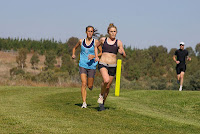I joined the Speedygeese this morning for an interval session on the
smooth grass of the Stromlo cross country course. That's six weeks in a
row of doing this particular training session. It's become a habit.
Philosopher and runner Jeff Edmonds wrote a blog post on running and
habit. He notes that runners are creatures of habit (which makes the
training process easy), but habit can also be the runner's worst enemy.
There's a danger of repeating the same old running routine if conscious
thought isn't given to what we might need to do in order to improve. If
you're a competitive runner that is! There's nothing wrong with getting
out the door for an easy 30-minute run each day. One may even enjoy
racing off such habitual easy running.
This morning I ran with Geoff and Andrew — 4 x 1km 'hard' efforts with easy 1km jog recoveries. It was a warm (24C) and calm morning. My times were about six seconds slower than for the same session on 18 November. Today I ran 4:23, 4:23, 4:20 and 4:18. Maximum heart-rate only reached 154 (previously 157), so perhaps I wasn't chasing Geoff as hard as when I was following Kym and Lucia. On the other hand, I wasn't feeling all that fresh — in spite of reducing yesterday's long run with Susan and Andy to 70 minutes.
I'm sure the habit of running 1k intervals at Stromlo is a good one for the summer. My legs need the speed and 4:18 kilometres are close to my 5k race pace. That speed isn't feeling easy though! I should do as Canute suggested and fit in some faster/sharper running — 100 to 200 metre repeats. Having a reserve of speed that's faster than 5k pace should make it feel easier. We'll see.
This morning I ran with Geoff and Andrew — 4 x 1km 'hard' efforts with easy 1km jog recoveries. It was a warm (24C) and calm morning. My times were about six seconds slower than for the same session on 18 November. Today I ran 4:23, 4:23, 4:20 and 4:18. Maximum heart-rate only reached 154 (previously 157), so perhaps I wasn't chasing Geoff as hard as when I was following Kym and Lucia. On the other hand, I wasn't feeling all that fresh — in spite of reducing yesterday's long run with Susan and Andy to 70 minutes.
I'm sure the habit of running 1k intervals at Stromlo is a good one for the summer. My legs need the speed and 4:18 kilometres are close to my 5k race pace. That speed isn't feeling easy though! I should do as Canute suggested and fit in some faster/sharper running — 100 to 200 metre repeats. Having a reserve of speed that's faster than 5k pace should make it feel easier. We'll see.
This morning's run — the 1k loop is around the dam.
























